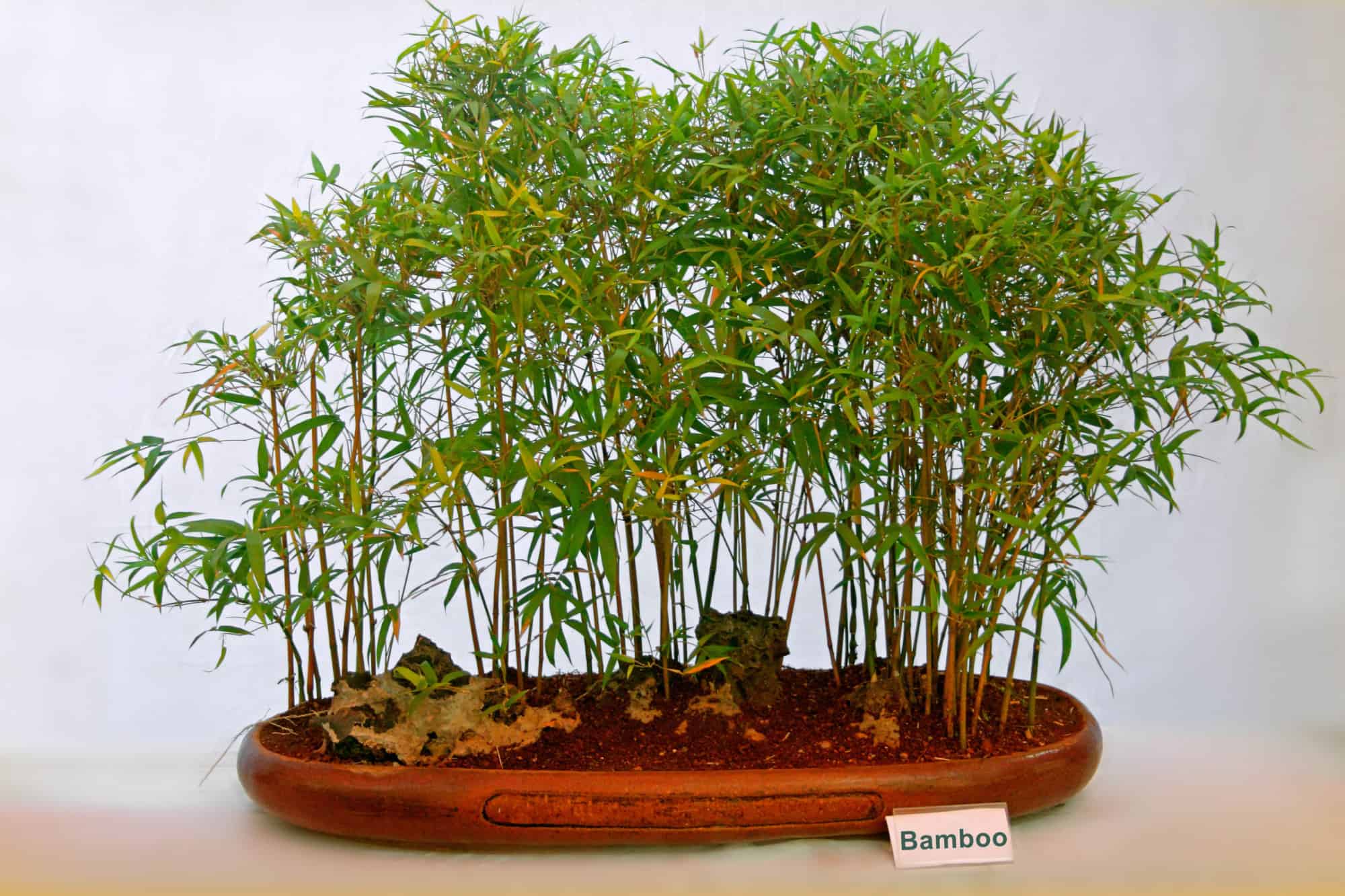Bamboo trees have been around long before humans. They are known for their tall, fast-growing stalks that are as majestic as they are useful. Despite growing at a quick pace, bamboo trees are a favorite when it comes to Bonsai trees. But what are the different types of bamboo that suit Bonsai best? How do you take care of a bamboo Bonsai tree?
Here is all that you need to know about caring for a bamboo Bonsai tree!
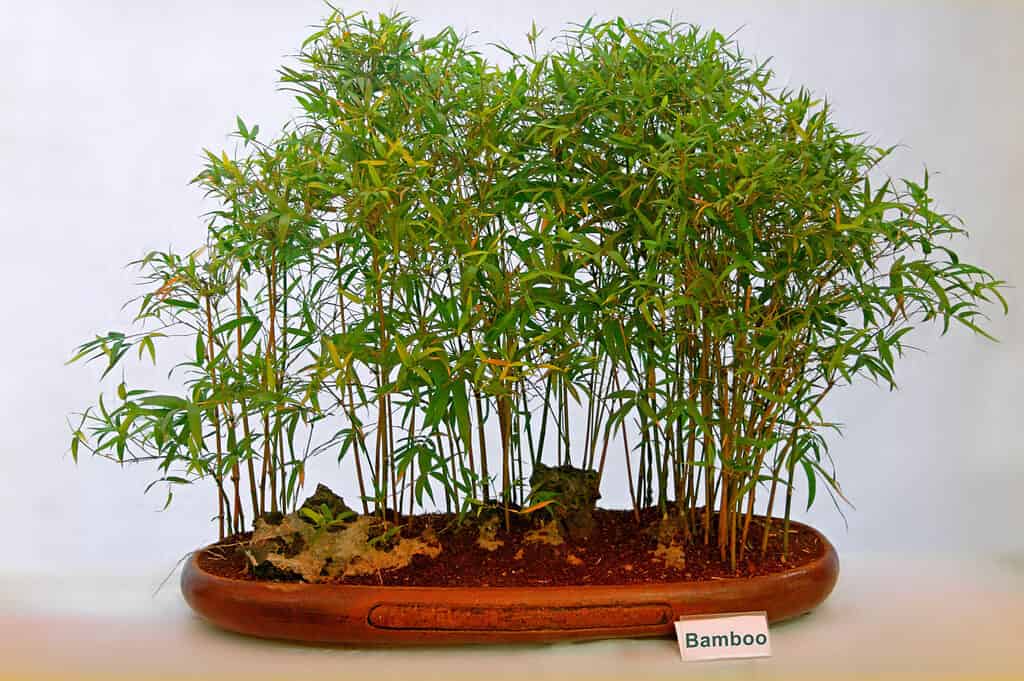
A forest Bonsai tree style suits bamboo plants well.
©yogesh_more/Shutterstock.com
| Bamboo Bonsai Tree Facts | |
|---|---|
| Botanical Name | Bambusa |
| Common Types | Tiny fern bamboo, Chinese dwarf bamboo, Mexican weeping bamboo, Dwarf whitestripe bamboo, Pygmy bamboo, Dragon Head bamboo, Fountain bamboo, Buddha’s Belly Bamboo |
| Sunlight | Depends on how much growth is wanted. Full sun equals more growth, while shade equals less. |
| Soil | Depends on the specific type of bamboo tree, but most are adaptable and will do well in normal Bonsai soil mix |
| Water | Consistently moist, but well-drained. Since they grow so quickly, they need a lot of water on a regular schedule. |
| For Beginners? | Beginner to Intermediate. Bamboo is hardy and resilient and can endure pruning. |
| Indoors or Outdoors? | Outdoors |
| Pairs Well With… | Rocks, moss, and other natural ornaments! |
Common Types of Bamboo Bonsai Trees
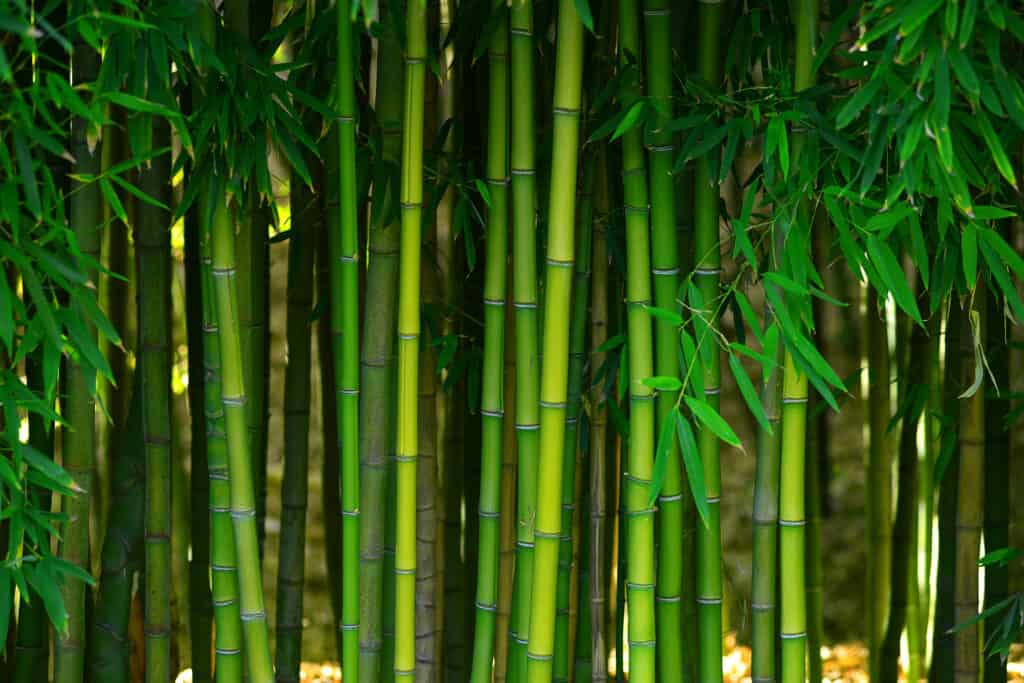
One of the reasons why bamboo plants make perfect Bonsai trees is because they are, for the most part, easier to care for than other plants.
©iStock.com/p-orbital
To grow a bamboo Bonsai tree well, it is best to stick with dwarf bamboo. Since these types of bamboo do not grow quite as large as other kinds of bamboo, they are the perfect choice for Bonsai trees.
Here are the most common types of bamboo Bonsai trees!
Tiny Fern Bamboo
Tiny fern bamboo is among the smallest bamboo plants. It boasts a natural height of up to 3 feet. Because it is so small and has such low maintenance, it is relatively easy for Bonsai beginners to plant and prune tiny fern bamboo. Its gray-green leaves are pointed and clumped together, creating a dense thicket.
Tiny fern bamboo thrives best beneath full to partial sunlight, especially in warm temperatures. It needs well-draining soil. Tiny fern bamboo is relatively hardy and can survive temperatures as low as 15F.
Chinese Dwarf Bamboo
Chinese dwarf bamboo is native throughout China and Southern Asia. It has lovely dark green leaves that somewhat retain their color throughout the year, especially if the plant is kept from the cold. Like most other bamboo types, Chinese dwarf bamboo is tropical. This means that it does best in warm temperatures and cannot survive extreme heat or cold.
Chinese dwarf bamboo plants prefer moist, acidic, well-draining loam. When they begin to grow, they grow fast.
Mexican Weeping Bamboo
Mexican weeping bamboo is indigenous throughout central Mexico through Central America. This plant thrives best in full to partial sunlight and prefers moist, well-draining soil. Once Mexican weeping bamboo plants are established and growing, they can resist drought. but it’s best to keep a regular watering schedule to ensure this plant grows its best.
Dwarf Whitestripe Bamboo
Dwarf whitestripe bamboo are evergreen plants, though their leaves are striped a unique white and green. They are native to Japan.
Dwarf whitestripe bamboo can tolerate full sun but really, these fast-growing plants thrive best beneath partial shade. They need moist, well-draining soil. As a whole, they are hardy plants that can tolerate temperatures just above freezing. But if they are left in these conditions, their leaves will die and temporarily lose their white-green coloring.
Pygmy Bamboo
Pygmy bamboo is one of the smallest types of bamboo. This plant can reach up to 2 feet in height when planted naturally. Because it is so small and easily maintained, it is among the best types of bamboo to be used in Bonsai. Pygmy bamboo plants are hardy plants that can tolerate temperatures just above freezing. They can tolerate full sun, but they do best beneath partial to full shade. They need moist, well-draining soil.
Dragon Head Bamboo
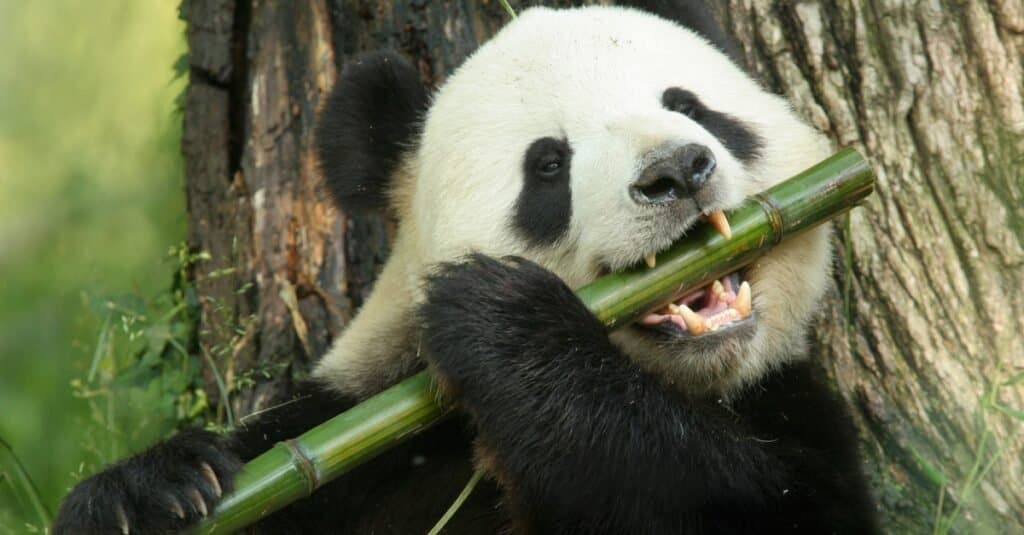
To grow best, a dragon head bamboo plant needs acidic, well-draining soil that is full of nutrients.
©Bryan Faust/Shutterstock.com
Dragon head bamboo is native to China. It is also referred to as Green Panda bamboo because Chinese pandas consume these plants often in the wild. These adaptable plants can grow in the shade. In fact, that is where they do best. They prefer warm temperatures to go along with it. They can survive temperatures as cold as -10F. Though they do not like high heat or humidity. To grow best, a dragon head bamboo plant needs acidic, well-draining soil that is full of nutrients.
Fountain Bamboo
Fountain bamboo is indigenous to China. The leaves on this lovely bamboo stay green throughout the year. The stems turn purple as they age. Fountain bamboo plants thrive best in partial sunlight and in shade. They enjoy warm temperatures but cannot stand high heat, humidity, or cold.
Buddha’s Belly Bamboo
Buddha’s belly bamboo is found throughout Southeast Asia. It is native, specifically, to Southern China and Vietnam. The stems on these plants are rounded. It is thought to resemble Buddha’s belly, hence the name! These plants do best in full to partial sunlight, but not direct sunlight. They are not too hardy, and cannot survive temperatures below 20F. They must be kept from winds and the cold.
Caring for Your Bamboo Bonsai Tree
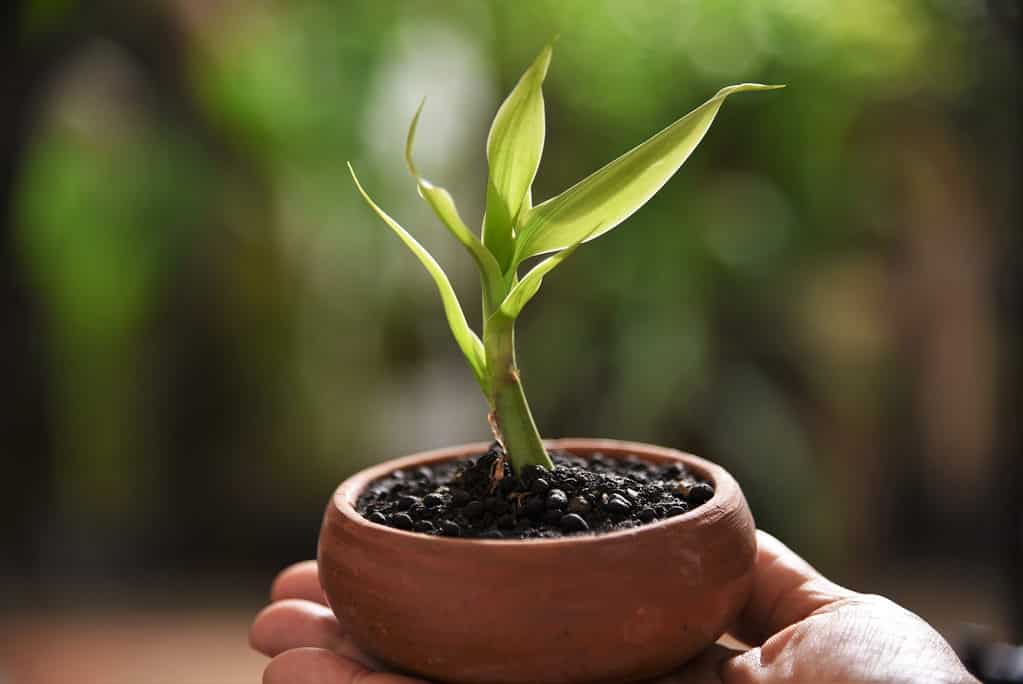
Certain varieties of bamboo plants are better suited for Bonsai tree cultivation than others.
©taveesak srisomthavil/Shutterstock.com
One of the reasons why bamboo plants make perfect Bonsai trees is because they are, for the most part, easier to care for than other plants. Bamboo trees are adaptable, in terms of sunlight, soil conditions, and environment. They still need care and attention to grow their best, however.
Here are some guidelines to properly care for your bamboo Bonsai tree!
Sunlight
For the most part, bamboo plants are adaptable and versatile. They can survive in different conditions when it comes to light. Even a lot of bamboo plants that prefer shade can still tolerate sunlight. It really just depends on how much growth you want from your bamboo Bonsai tree. Placing it beneath full to partial sunlight more often will result in more growth. More growth results in more pruning and maintenance.
Soil Type
As a whole, bamboo plants require moist, well-draining soil to grow their best. Some need acidic soil while others do not. All bamboo Bonsai trees should do just fine with a regular Bonsai tree soil mixture!
Water
Since bamboo plants grow quickly, they need plenty of water. It is important to keep them moist and watered as much as possible. This ensures that they grow well!
Placement
Choosing where and how to place your Bonsai tree can be tricky. Thankfully, bamboo Bonsai trees make it easy!
As a whole, most bamboo plants can stay outside year-round. Some are more susceptible to frost and cold temperatures than others. While most bamboo plants cannot tolerate high heat or humidity. If they are exposed to these conditions, the leaves can die. It is best to move them indoors for a period of time if outdoor conditions are extremely cold or extremely hot.
Pruning Your Bamboo Bonsai Tree

Because most bamboo plants tend to grow straight and upright, the most popular choice for bamboo Bonsai tree styles is generally the Yose-ue style.
©GrooTrai/Shutterstock.com
With bamboo Bonsai trees, it is best to focus all of your attention on pruning as opposed to wiring. The denser the growth of your bamboo Bonsai tree, the more pruning you will have to do. Since most bamboo plants grow quickly, it is important to prune them as they grow.
Ideal Bamboo Bonsai Tree Styles
Because most bamboo plants tend to grow straight and upright, the most popular choice for bamboo Bonsai tree styles is generally the Yose-ue style. This is also known as the forest style. It is possible to style bamboo Bonsai trees into other styles, but it is definitely not easy.
Propagating Your Bamboo Bonsai Tree
For the most part, bamboo trees are easily propagated. They can grow from cuttings without too many problems or extra work on your part. Ensure that your cuttings for your bamboo Bonsai tree are five inches in length or shorter!
Common Problems with Bamboo Bonsai Trees
As a whole, bamboo plants are very hardy and resilient. When they are established, mature, and healthy, they should not have too many issues with insects or pests.
Thank you for reading! Have some feedback for us? Contact the AZ Animals editorial team.

